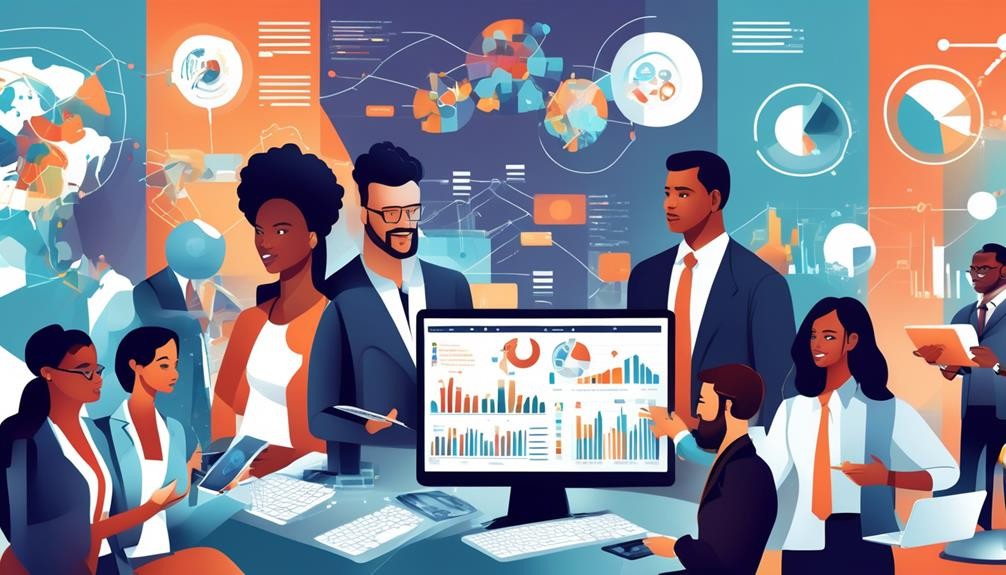Have you ever wondered why there isn’t a good marketplace for connecting modern cloud-based alternatives to legacy apps? If you’re into the tech world like me, this question might have popped into your mind at least one time. The only answer noticed over time is although there may or may not be a marketplace, there aren’t many classic tech stack apps in the App Store.
So, if you’re the owner of an app that isn’t available on the store, it could be time to engage in application modernization services.
According to a news release by GlobeNewswire, the global application modernization services market is expected to value around USD 24.8 billion by 2030.
The IT sector is going through a significant revolution. While some brand-new technologies constantly change, others are stalling here and there. At this stage, it is crucial to understand that a bamboozled technical solution loses the company money and effort.
Therefore, in today’s time, data owns the throne, and the majority of organizations use a data-driven approach to operate. Luckily, we are in the midst of this golden age. Technology is increasingly becoming recognized by businesses as a resource. Tech solutions also have an uncertain shelf life, unlike hardware systems. This is the reason why most companies in today’s time embrace legacy application modernization.
Legacy modernization solutions and techniques integrate cutting-edge technological innovations specially made to satisfy present-day business requirements.
But how to make it happen?
So, in this article, I’ll tell you how to accomplish this to help you position yourself to fulfill client expectations, overcome business challenges, and redefine your business.
So, let’s begin this short and sweet ride.
What is Legacy System?
A legacy system is a set of outdated procedures, software, and physical infrastructure. Legacy systems are often situated in monolithic, tightly connected environments and utilize customer-owned, hosted, maintained, and supported hardware and software. These systems are functional, but they can be costly to operate and maintain, and they call for specialized IT skills that are difficult to acquire.
Moreover, on a dull note, they even restrict your capacity for innovation and creativity.
What is Application Modernization?
Legacy application modernization involves modernizing old and outdated IT systems, software, and processes to eliminate data silos and put the business on the trail to data empowerment. The organization’s overall attempt to increase efficiency, become more creative, and promote growth is known as digital transformation.
Thereby, a legacy application modernization rests in the technology arm of the people-process-technology triangle as part of digital transformation. You evaluate the demands of your company, choose which aspects to update first, put together a plan, and carry it out.
I’ve outlined the seven significant steps for developing a strategy and modernizing outdated applications. Use them as a foundation as you create your business case and plan.
However, before that, first, let’s discuss other important aspects of legacy application modernization.
Why Modernize Legacy Applications?
Okay, let’s put this question in another way. Why might businesses need to modernize a legacy application? In this era of digitization, opting for app modernization solutions is of utmost importance. To survive in this competitive market, every business needs to have the upper hand on its competitors and advance as technology advances.
Let’s now discuss why legacy app modernization is crucial for companies nowadays.
- Adherence to Modern Trends – When you think of it, your legacy application was most likely developed years ago in alignment with historical facts and trends. However, time flies, and nothing in the world stays constant. What was a fashion trend yesterday is now outdated. The same is the case with our software solutions. Therefore, you need to modernize legacy systems to keep up with the rapid development and modern trends.
- Utilizing Innovative Procedures – Every business grows and opts to use different technologies, legacy systems, however, cannot handle every new update. Therefore, it is essential to modernize the organization’s apps to accomplish specific goals to continue growing past a certain point.
- Cost-Cutting – You can lower the expense of new tools, for instance, by upgrading your company’s outdated but still-in-use software. App modernization services will cost you significantly less than purchasing new ones or developing them from scratch.
- Work Optimization – If you want to improve the efficiency of your company’s or business workflows, legacy application modernization is essential. An out-of-date software might hinder productivity and give your staff members negative thoughts. A modernized legacy app will benefit your company’s operations in terms of speed, quality, and efficiency.
- Considers Futuristic Needs and Approaches – If you expect your business to grow and have different requirements in the future, you should consider modernizing your legacy apps. After all, an outdated system is unlikely to be able to handle this if business evolves and you have new needs and expectations.
- Address Challenges and Setbacks – You must set up the organization’s internal systems to function correctly in order to avoid issues of process failures in your businesses. In this regard, your company’s legacy systems will help in many ways if you modernize them. You can optimize your process and accelerate the completion of your company’s objectives by improving application performance.
I guess these reasons are enough to make you understand the importance of modernizing legacy systems.
Key Technologies for Application Modernization
Organizations nowadays frequently emphasize ‘modernization,’ which refers to utilizing several essential technologies. Here, we’ll discuss the same.
- Microservices – Most legacy applications are monolithic or single-tier, self-contained apps. Increasing adaptability to meet shifting consumer and staff expectations is one of the fundamental driving forces of modernization. Most businesses choose a microservices model that provides services connected via API. This enables them to pick and choose best-in-class solutions to meet shifting customer demands or scale as necessary.
- Automation and Orchestration – While orchestration automates numerous operations as a process or workflow, automation sets up each activity to execute independently. Introducing implementation, networking, scaling, and security benefits through automation and orchestration.
- Cloud Computing – The legacy application modernization approach always includes re-platforming and rehosting apps on the cloud. By utilizing various solutions, such as public, private, hybrid, and multi-cloud, organizations can help reap the advantages of cloud computing – such as agility, scalability, and cost-effectiveness.
- Kubernetes and Containers – Containers are used for packaging purposes, and deployment and operation of cloud software solutions prove advantageous for expansion and mobility. Kubernetes, therefore, is a method for orchestrating containers that automate processes.
Now, let’s move to our article’s last but most important topic. Here, we’ll discuss the strategies utilized by various app modernization services.
7 Best Legacy Applications Modernization Strategies
To modernize legacy systems, there are seven common strategies, also known as the ‘seven Rs,’ each with a different level of complexity and reward. The best choice for your company will help in cost-cutting and enhanced operational flexibility. Legacy code refactoring provides support for restructuring and optimizing existing code without changing external functionality. This facilitates long-term sustainability of valuable business logic encoded within legacy systems. The seven Rs include retire, retain, rehost, replatform, repurchase, rearchitect, rewrite/replace. Legacy code refactoring support sits alongside these as a focused tactic for transforming legacy codebases to better prepare them for integration with modern architectures. The optimal path forward requires carefully weighing business context, technical debt, and modernization priorities unique to each legacy environment against the spectrum of options now available.
Let’s now, one by one, understand these seven Rs of legacy application modernization.
1. Replace
Decommission all the existing legacy components completely, then swap them out.
In this method, the company entirely dismantles the current system and replaces it with a new design that considers new requirements and business processes. For example, you can return your in-house CRM system with Salesforce CRM or switch from a standard email system to cloud-based Microsoft 365.
2. Rebuild
Restructure and enhance legacy components in a way that is compatible with the cloud. A complete rebuild is the most time-consuming and costly option, but it offers the most significant rewards.
A complete rebuild rearranges the legacy system into a fully updated, cloud-native environment, in contrast to the other techniques that only partially utilize the modernistic infrastructure. Companies use DevOps methodologies to accomplish this. Technologies like microservices, containers, declarative APIs, etc., can also be adopted.
3. Replatform
Deploy runtimes on a modern platform. The re-platforming strategy transfers an application’s elements to a new runtime platform with little or no code modifications and the ditto functionalities.
Programmers can move the code to the new platform without altering the code’s structure or the system’s functionalities and features. There are compilers available that enable application porting from one platform to other. A company can benefit from greater efficiency and lower infrastructure with little effort.
4. Rehost
Rehosting is the deployment of legacy systems into a new environment (cloud infrastructure, virtual or physical) without recompiling, changing the code, or affecting functionality.
Rehosting enables businesses to keep investing in legacy software, such as databases and ERP, while benefiting from the cloud’s underlying infrastructures’ improved performance and security. It is also referred to as the lift and shift migration strategy. This enables businesses to migrate to the cloud more rapidly without restructuring or re-engineering their current systems.
5. Re-Architect and Rebuild
Utilizing cloud-based or other systems involves deploying new technologies in the application’s tiers and making code changes in specific layers.
This choice takes advantage of changing some components of the legacy systems to optimize code for more excellent performance; it is typically used in hybrid environments. Generally, this requires modifying legacy systems’ backends without significantly altering their frontends or functioning. Although there may be technological limitations on what may be done, this is less disruptive than a total overhaul.
6. Retain
Continue with the present state without making any updates or modifications.
There might not be a strong enough argument for modernization due to an upcoming merger, a declaration of end-to-life, or another factor. Even though the immediate choice is to keep, there should be a long-term plan to guarantee the continuity of vital operations. Retention is a temporary strategy rather than a long-term goal of action. Organizations should use caution while implementing this kick-it-down-the-road strategy.
7. Retire
After analyzing the consumption, business consequences, and workloads, retire the system completely.
After evaluating the workload, you may decide that it would be wise to retire the system and transfer any remaining users to alternative methods.
Conclusion!
The main objective of legacy app modernization is to give the business and IT sector better knowledge of the data landscape. With the help of modernizing legacy systems, you can also ensure resiliency.
Lastly, legacy application modernization brings business and IT together by balancing business needs against the IT sector’s capacity to fulfill them.
But how to accomplish this?
I would recommend you use app modernization services. The services can help your organization modernize its outdated systems, update its IT architecture, and improve its operational performance.
This is all from my end.
Thank you!











